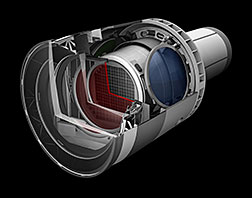- Number 433 |
- February 23, 2015
Software, supercomputers are key to exploring astronomical mysteries

Rendering of the LSST camera. SLAC is
leading the construction of the 3,200-
megapixel camera, which will be the size
of a small car and weigh more than 3 tons.
Credit: SLAC National Accelerator Laboratory
The Large Synoptic Survey Telescope, whose construction is led by DOE’s SLAC National Accelerator Laboratory, is currently in the advanced design phase. Placed in Cerro Pachon, Chile, it will enable the world's largest imaging survey, taking repeated images of the southern sky beginning in 2020.
"LSST will truly be a next-generation survey: It will surpass preceding surveys in terms of data size in its first few months of operation," said University of Pennsylvania astrophysicist Bhuvnesh Jain, spokesperson for the Dark Energy Science Collaboration of the LSST.
Innovative DESC software, developed at DOE’s Fermi National Accelerator Laboratory in collaboration with other institutions, will enable scientists to explore the many astronomical mysteries that the LSST will open up. At SC14, the supercomputing conference held in November, Fermilab scientists achieved a milestone with a successful demonstration run of the DESC analysis framework software.
"The demo was an end-to-end simulation of LSST data and science analyses — that was the really important thing," said Fermilab’s Steve Kent. "It was a walking-through of all the steps and with an eye on eventually expanding to the LSST scale."
Scott Dodelson, Fermilab astrophysicist and convener of the DESC Software Working Group, says the group is designing a framework for all DESC scientists that will facilitate their collaboration and use of tools built by the LSST project team.
The framework links some programs specifically produced for LSST with others written externally or by scientists themselves. It runs them on supercomputers, networks such as FermiGrid and local resources.
"The scientists running the DESC workflows will not have to worry about details such as file transport or access to supercomputers to do their dark energy science," explained Marc Paterno of Fermilab’s Scientific Computing Division. "We demonstrated how this could be done."
Fermilab’s Saba Sehrish and the rest of the group ran simulated images through the interlinked software until at the end it was run through CosmoSIS, a cosmological parameter estimation program to which Fermilab scientists have contributed.
"The work of the Fermilab group is really going to pave the way for a new mode of doing software analyses and how people collaborate," Jain said. "I think it will have far-reaching implications for how we do cosmology."
More than 200 scientists from five countries are currently involved with DESC, and Jain expects the number of scientists involved in DESC to double in the next decade. – Rich BlausteinSubmitted by DOE’s Fermilab
